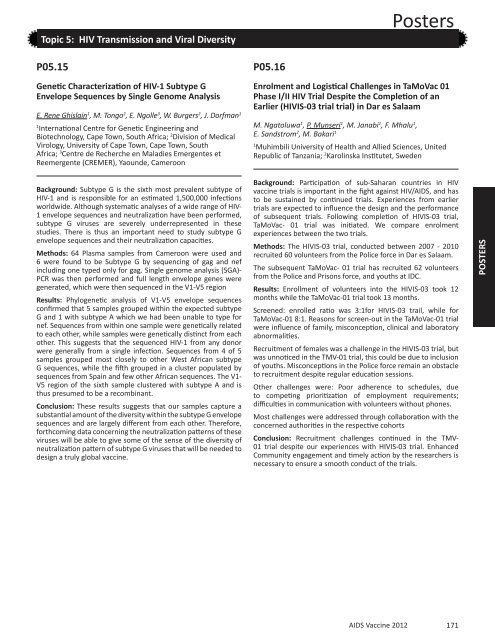Oral Abstract Session 01 - Global HIV Vaccine Enterprise
Oral Abstract Session 01 - Global HIV Vaccine Enterprise
Oral Abstract Session 01 - Global HIV Vaccine Enterprise
Create successful ePaper yourself
Turn your PDF publications into a flip-book with our unique Google optimized e-Paper software.
Topic 5: <strong>HIV</strong> Transmission and Viral Diversity<br />
P05.15<br />
Genetic Characterization of <strong>HIV</strong>-1 Subtype G<br />
Envelope Sequences by Single Genome Analysis<br />
E. Rene Ghislain 1 , M. Tongo 2 , E. Ngolle 3 , W. Burgers 2 , J. Dorfman 1<br />
1 International Centre for Genetic Engineering and<br />
Biotechnology, Cape Town, South Africa; 2 Division of Medical<br />
Virology, University of Cape Town, Cape Town, South<br />
Africa; 3 Centre de Recherche en Maladies Emergentes et<br />
Reemergente (CREMER), Yaounde, Cameroon<br />
Background: Subtype G is the sixth most prevalent subtype of<br />
<strong>HIV</strong>-1 and is responsible for an estimated 1,500,000 infections<br />
worldwide. Although systematic analyses of a wide range of <strong>HIV</strong>-<br />
1 envelope sequences and neutralization have been performed,<br />
subtype G viruses are severely underrepresented in these<br />
studies. There is thus an important need to study subtype G<br />
envelope sequences and their neutralization capacities.<br />
Methods: 64 Plasma samples from Cameroon were used and<br />
6 were found to be Subtype G by sequencing of gag and nef<br />
including one typed only for gag. Single genome analysis (SGA)-<br />
PCR was then performed and full length envelope genes were<br />
generated, which were then sequenced in the V1-V5 region<br />
Results: Phylogenetic analysis of V1-V5 envelope sequences<br />
confirmed that 5 samples grouped within the expected subtype<br />
G and 1 with subtype A which we had been unable to type for<br />
nef. Sequences from within one sample were genetically related<br />
to each other, while samples were genetically distinct from each<br />
other. This suggests that the sequenced <strong>HIV</strong>-1 from any donor<br />
were generally from a single infection. Sequences from 4 of 5<br />
samples grouped most closely to other West African subtype<br />
G sequences, while the fifth grouped in a cluster populated by<br />
sequences from Spain and few other African sequences. The V1-<br />
V5 region of the sixth sample clustered with subtype A and is<br />
thus presumed to be a recombinant.<br />
Conclusion: These results suggests that our samples capture a<br />
substantial amount of the diversity within the subtype G envelope<br />
sequences and are largely different from each other. Therefore,<br />
forthcoming data concerning the neutralization patterns of these<br />
viruses will be able to give some of the sense of the diversity of<br />
neutralization pattern of subtype G viruses that will be needed to<br />
design a truly global vaccine.<br />
P05.16<br />
AIDS <strong>Vaccine</strong> 2<strong>01</strong>2<br />
Posters<br />
Enrolment and Logistical Challenges in TaMoVac <strong>01</strong><br />
Phase I/II <strong>HIV</strong> Trial Despite the Completion of an<br />
Earlier (<strong>HIV</strong>IS-03 trial trial) in Dar es Salaam<br />
M. Ngatoluwa 1 , P. Munseri 1 , M. Janabi 1 , F. Mhalu 1 ,<br />
E. Sandstrom 2 , M. Bakari 1<br />
1 Muhimbili University of Health and Allied Sciences, United<br />
Republic of Tanzania; 2 Karolinska Institutet, Sweden<br />
Background: Participation of sub-Saharan countries in <strong>HIV</strong><br />
vaccine trials is important in the fight against <strong>HIV</strong>/AIDS, and has<br />
to be sustained by continued trials. Experiences from earlier<br />
trials are expected to influence the design and the performance<br />
of subsequent trials. Following completion of <strong>HIV</strong>IS-03 trial,<br />
TaMoVac- <strong>01</strong> trial was initiated. We compare enrolment<br />
experiences between the two trials.<br />
Methods: The <strong>HIV</strong>IS-03 trial, conducted between 2007 - 2<strong>01</strong>0<br />
recruited 60 volunteers from the Police force in Dar es Salaam.<br />
The subsequent TaMoVac- <strong>01</strong> trial has recruited 62 volunteers<br />
from the Police and Prisons force, and youths at IDC.<br />
Results: Enrollment of volunteers into the <strong>HIV</strong>IS-03 took 12<br />
months while the TaMoVac-<strong>01</strong> trial took 13 months.<br />
Screened: enrolled ratio was 3:1for <strong>HIV</strong>IS-03 trail, while for<br />
TaMoVac-<strong>01</strong> 8:1. Reasons for screen-out in the TaMoVac-<strong>01</strong> trial<br />
were influence of family, misconception, clinical and laboratory<br />
abnormalities.<br />
Recruitment of females was a challenge in the <strong>HIV</strong>IS-03 trial, but<br />
was unnoticed in the TMV-<strong>01</strong> trial, this could be due to inclusion<br />
of youths. Misconceptions in the Police force remain an obstacle<br />
to recruitment despite regular education sessions.<br />
Other challenges were: Poor adherence to schedules, due<br />
to competing prioritization of employment requirements;<br />
difficulties in communication with volunteers without phones.<br />
Most challenges were addressed through collaboration with the<br />
concerned authorities in the respective cohorts<br />
Conclusion: Recruitment challenges continued in the TMV-<br />
<strong>01</strong> trial despite our experiences with <strong>HIV</strong>IS-03 trial. Enhanced<br />
Community engagement and timely action by the researchers is<br />
necessary to ensure a smooth conduct of the trials.<br />
171<br />
POSTERS


